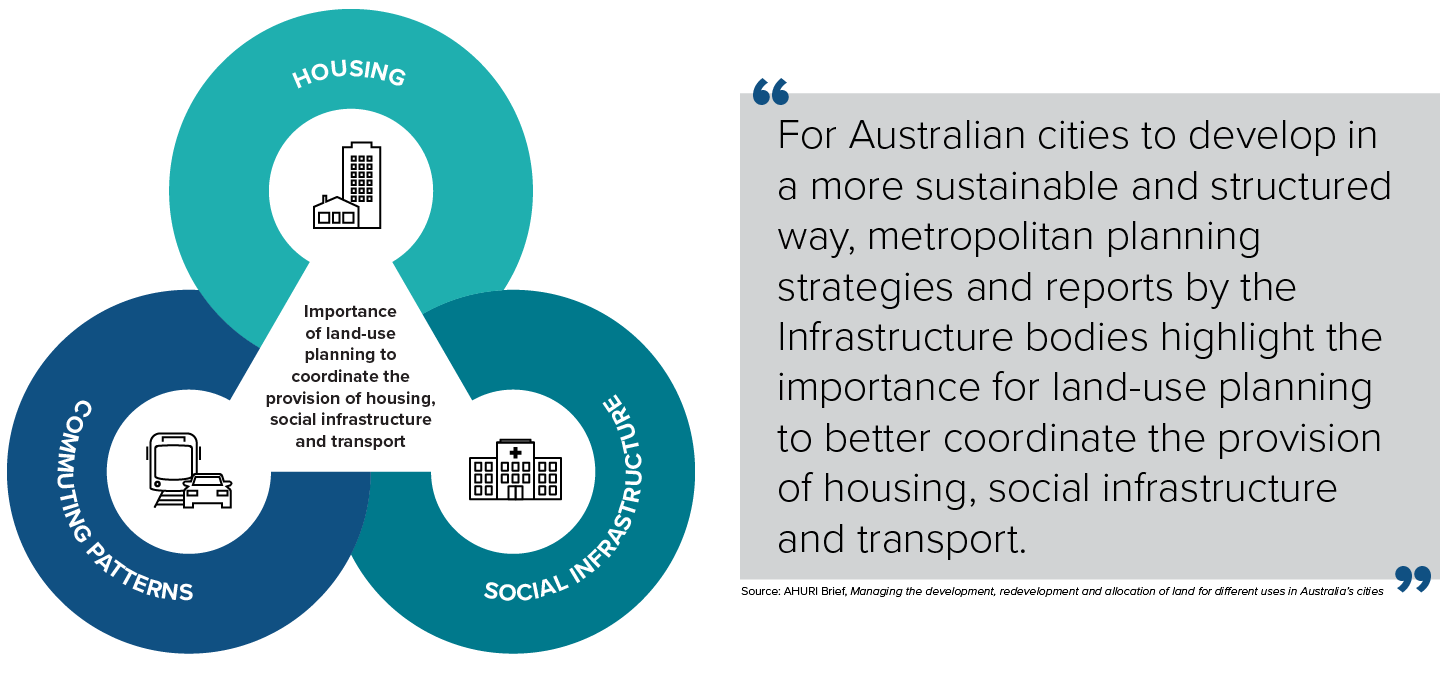Urban policy frameworks in Australia feature provisions for the development and use of land. The re-zoning of land on the urban fringe and the redevelopment and subdivision of property in existing urban areas, especially for new or more intensive residential use, is essential to accommodating urbanization and the dynamic populations of Australian cities.
For Australian cities to develop in a more sustainable and structured way, metropolitan planning strategies and reports by the Infrastructure bodies highlight the importance for land-use planning to better coordinate the provision of housing, social infrastructure and transport. To facilitate broader economic, environmental and social outcomes, urban policies refer to the potential of mechanisms that capture a proportion of the increased value of land that has been redeveloped.

Land-supply
The supply of residential, industrial and commercial land is a primary concern for urban policies that support the growth of Australia’s cities. The Australian government’s Smart Cities Plan states that one of the objectives of a City Deal is to maximise the benefits of underutilised public land and boost the supply of land for diverse uses.
Metropolitan planning strategies connect the supply of land closely to the provision of housing to accommodate the growing population and to meet shifting household needs. AHURI research has examined how land use planning mechanisms can support including affordable housing within new and renewing communities, finding that these mechanisms work best when they are part of a wider whole-of-government strategy. Urban policies evaluate current levels of residential land supply in relation to projected future needs and sometimes set targets for infill sites and greenfield developments. For example, the Perth and Peel@3.5 million strategy in Western Australia states that the existing spatial plan encompasses sufficient undeveloped land to accommodate a projected population of 3.5 million people by 2050 if infill and density targets are met.
Land-use planning
Urban policies rely on land-use planning to achieve their objectives. A strategic objective of the Greater Sydney Region Plan: A Metropolis of Three Cities is to continuously improve the integration of land-use, transport and infrastructure planning between the three tiers of government and across state agencies. Current strategic land-use planning initiatives could be linked more effectively with infrastructure to support jobs and housing growth. Upcoming AHURI research is identifying ways to better coordinate and deliver infrastructure and services to support growth in different urban contexts while meeting the needs and expectations of present and future communities.
Infrastructure Victoria recommends improving the land-use planning for high growth areas to provide infrastructure in a timely manner. Land-use planning can encapsulate new infrastructure as well as retrofitting existing infrastructure. The Central Darwin Area Plan argues that a better integration of land-use planning in corresponding long-term infrastructure plans sets the direction for a more sustainable and structured development.
Urban development
Metropolitan planning strategies are focusing on the urban consolidation of Australian cities. A key topic is the redevelopment of existing urban areas for commercial, residential and recreational uses. AHURI research has investigated integrative development approaches in the ‘greyfields’ of Australian cities to accommodate population increases, create affordable and diverse housing and make better use of existing infrastructure and amenity, including more efficient use of land.
The Smart Cities Plan highlights the potential of value capture mechanisms to utilise the uplift of land value for urban development, for example through land rezoning or better infrastructure. The plan argues that value capture is a way to distribute the costs and benefits of publicly funded infrastructure to facilitate a project that may not otherwise occur. Urban policies rely on value capture to make infrastructure more affordable, deliver projects sooner, and accelerate urban renewal and housing supply.

